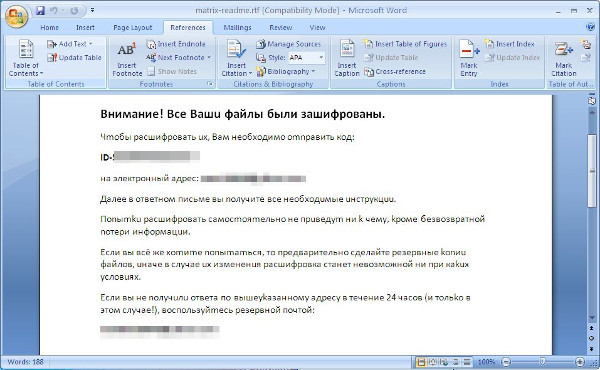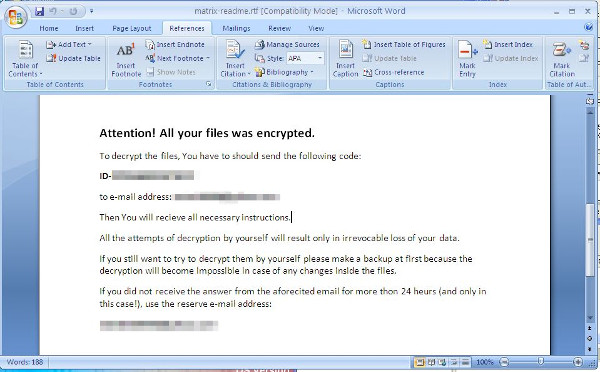RANSOM_MATRIX.A
Trojan:Win32/Dynamer!ac (Microsoft)
Windows


Threat Type: Trojan
Destructiveness: No
Encrypted: No
In the wild: Yes
OVERVIEW
Downloaded from the Internet, Dropped by other malware
This Trojan arrives on a system as a file dropped by other malware or as a file downloaded unknowingly by users when visiting malicious sites.
TECHNICAL DETAILS
1,156,096 bytes
EXE
No
30 Nov 2016
Drops files, Encrypts files, Renames files,
Arrival Details
This Trojan arrives on a system as a file dropped by other malware or as a file downloaded unknowingly by users when visiting malicious sites.
Installation
This Trojan drops the following files:
- %Application Data%\gnupg
- %Application Data%\gnupg\pubring.bak
- %Application Data%\gnupg\pubring.gpg
- %Application Data%\gnupg\pubring.gpg.lock
- %Application Data%\gnupg\random_seed
- %Application Data%\gnupg\secring.gpg
- %Application Data%\gnupg\secring.gpg.lock
- %Application Data%\gnupg\trustdb.gpg
- %Application Data%\gnupg\trustdb.gpg.lock
- {malware path}\{random characters}.MTK - contains PGP Public Key Block
- {malware path}\{6 random characters}.cmd - contains command to overwrite space of deleted files from hard drives.
- {malware path}\{6 random characters}.cmd - contains commands to copy and replace files from malware folder to various destinations.
- {malware path}\{6 random characters}.cmd - contains commands to
- use different character sets
- edit auto start registry entry
- force delete all .exe, .MTK, .vbs, .cmd files in the malware path
- {malware path}\autoclean.vbs - script that executes the .cmd file that contains command to overwrite space of deleted files from hard drives
- %Application Data%\Microsoft\{6 random characters}.vbs - Contains script to delete shadow copies
- {folder of encrypted files}\matrix-readme.rtf - ransom note
- {malware path}\{6 random characters}.vbs - Contains script to delete shadow copies
- {malware path}\svchost.exe
(Note: %Application Data% is the Application Data folder, where it usually is C:\Documents and Settings\{user name}\Application Data on Windows 2000, Windows Server 2003, and Windows XP (32- and 64-bit); C:\Users\{user name}\AppData\Roaming on Windows Vista (32- and 64-bit), Windows 7 (32- and 64-bit), Windows 8 (32- and 64-bit), Windows 8.1 (32- and 64-bit), Windows Server 2008, and Windows Server 2012.)
It creates the following folders:
- %Application Data%\gnupg
(Note: %Application Data% is the Application Data folder, where it usually is C:\Documents and Settings\{user name}\Application Data on Windows 2000, Windows Server 2003, and Windows XP (32- and 64-bit); C:\Users\{user name}\AppData\Roaming on Windows Vista (32- and 64-bit), Windows 7 (32- and 64-bit), Windows 8 (32- and 64-bit), Windows 8.1 (32- and 64-bit), Windows Server 2008, and Windows Server 2012.)
Autostart Technique
This Trojan adds the following registry entries to enable its automatic execution at every system startup:
HKEY_CURRENT_USER\Software\Microsoft\
Windows\CurrentVersion\Run
{malware filename} = "{malware path}\{malware filename}.exe"
Other System Modifications
This Trojan adds the following registry entries as part of its installation routine:
HKEY_CURRENT_USER\Software\Microsoft\
Windows\CurrentVersion\Run
{6 random characters}.vbs = "wscript //B //Nologo "%Application Data%\Microsoft\{6 random characters}.vbs""
Other Details
This Trojan renames encrypted files using the following names:
- {random characters}.id-{ID}.MATRIX
NOTES:
The ransomware drops the following ransom notes:


SOLUTION
9.800
12.932.08
30 Nov 2016
12.933.00
01 Dec 2016
Step 1
Before doing any scans, Windows XP, Windows Vista, and Windows 7 users must disable System Restore to allow full scanning of their computers.
Step 2
Note that not all files, folders, and registry keys and entries are installed on your computer during this malware's/spyware's/grayware's execution. This may be due to incomplete installation or other operating system conditions. If you do not find the same files/folders/registry information, please proceed to the next step.
Step 3
Delete this registry value
Important: Editing the Windows Registry incorrectly can lead to irreversible system malfunction. Please do this step only if you know how or you can ask assistance from your system administrator. Else, check this Microsoft article first before modifying your computer's registry.
- In HKEY_CURRENT_USER\Software\Microsoft\Windows\CurrentVersion\Run
- {malware filename} = "{malware path}\{malware filename}.exe"
- {malware filename} = "{malware path}\{malware filename}.exe"
- In HKEY_CURRENT_USER\Software\Microsoft\Windows\CurrentVersion\Run
- {6 random characters} = "%Application Data%\{6 random characters}.vbs"
- {6 random characters} = "%Application Data%\{6 random characters}.vbs"
Step 4
Search and delete these folders
- %Application Data%\gnupg
Step 5
Search and delete this file
- %Application Data%\Microsoft\{6 random characters}.vbs
- {malware path}\{random characters}.MTK
- {malware path}\{6 random characters}.cmd
- {malware path}\svchost.exe
- {malware path}\autoclean.vbs
- {folder of encrypted files}\matrix-readme.rtf
Step 6
Scan your computer with your Trend Micro product to delete files detected as RANSOM_MATRIX.A. If the detected files have already been cleaned, deleted, or quarantined by your Trend Micro product, no further step is required. You may opt to simply delete the quarantined files. Please check this Knowledge Base page for more information.
Step 7
Restore encrypted files from backup.
Did this description help? Tell us how we did.

